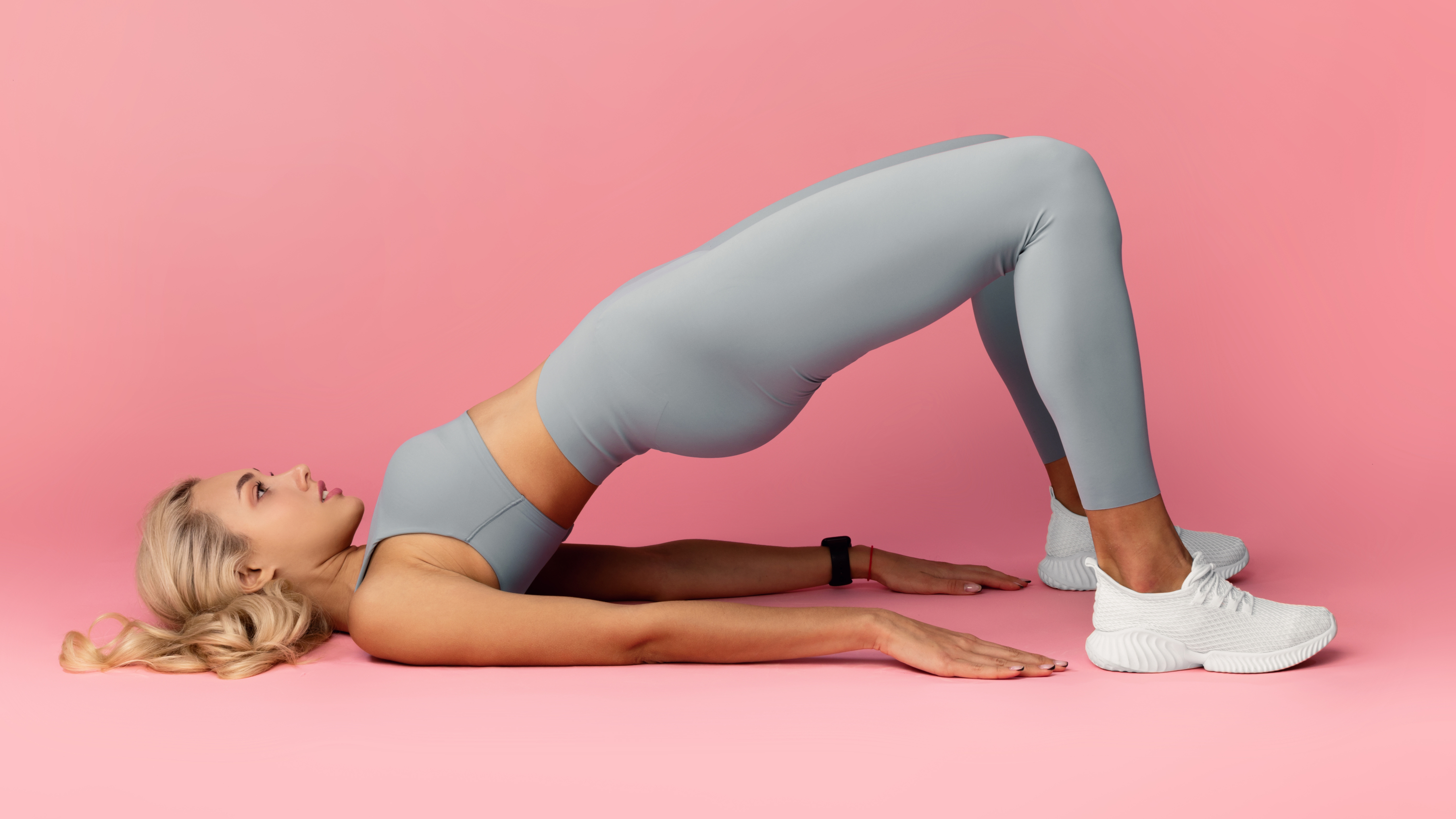
It doesn’t matter who you are — there will always be that one body part, exercise, or both, that you just hate training. For me, it’s the glutes.
A big ol’ set of thick glutes is the coveted goal of many gymgoers right now. But how good your butt looks in a pair of Gymshark ruched leggings isn’t the only reason you should be thinking about building strength and muscle in your glutes. More on that later.
Unless you take your glute training seriously, one set of muscles that don’t get as much love in the gym is the outer glutes, also known as the gluteus medius. And an exercise that hits those muscles hard is the butterfly glute bridge. So, I went all in and did 100 reps daily for two weeks. Here’s how I got on.
What does the butterfly glute bridge work?
If you’ve already learned how to do the glute bridge and need a little more spice in your life, the butterfly glute bridge alters your foot position to help target the adductors (inner thighs), gluteus medius (outer glutes) and hip flexors through hip extension.
You can perform them bodyweight if you like to work glute activation exercises into your strength programs before leg day or load them at the hips using free weights like dumbbells or barbells to work muscles through greater resistance during your workouts. Just be careful as your lower back can be more vulnerable.
Butterfly bridges or "open-clam glute bridges" require core activation and work the whole glute complex to help build glute strength, which can also benefit your lower body by protecting your lower back.
How to do butterfly glute bridges
- Lay on your back and bring the soles of your feet together, allowing your knees to fall to the sides
- Brace your core and slightly tuck your pelvis toward you to flatten your lower back toward the mat. Place your hands by your sides
- As you exhale, press your hips upward and squeeze your glutes as you extend at the hips
- Pause at the top, then slowly lower your hips on the inhale, starting at the top of your spine and lowering your butt last.
Keep your core and glutes tight and press through the outer sides of your feet as you lift.
Here’s what happened when I repped out 100 of these each day for two weeks.
It took ages
The key to this movement is control: press upward in one sweep of the hips, pause, then lower for at least 3 seconds to feel every inch of this movement in your glutes. I opted for 5 sets of 20 reps using my body weight, and boy, did it take a while.
But given I neglect my glutes the most of any body part, I knew it was high time I gave them the love they deserved, so 100 reps a day stayed.
My outer glutes really fired up
I find glute activation challenging, and I teach weightlifting for a living. We all talk about bracing the core, but actively bracing your glutes during exercise significantly helps to protect the lower back. Plus, underactive glutes are common, especially in quad-dominant runners, so over time, repeated underfiring could overload other muscle groups and place more strain on your hamstrings, hips, or lower back.

The three main gluteal muscles are the gluteus maximus, medius and minimus. Together, they’re responsible for maintaining posture and proper lower body mechanics, connecting at various points of the hips to help stabilize, move, and align your pelvis, trunk and hips. Your glutes also help rotate the hip joints and improve balance and coordination between the left and right sides.
In the words of Robbie Williams, “They offer me protection.”
Many people focus on glute exercises that target the largest, most powerful glute muscle — the gluteus maximus. The upper glutes get a little neglected, but when trained properly, can help create a more well-rounded shape. This simple and no-frills exercise really fired up my inner thighs and outer glutes and offered a relaxing stretch after sitting down and writing all day.
It was fun doing something different
We can all get stuck in a bit of an exercise rut at times, so I always challenge my clients to try something new. Lying on my yoga mat and pumping out 100 butterfly glute bridges each day certainly ticks that box.
Besides, I felt like I’d climbed thousands of steps by the end of the fortnight. And that was before I wrapped one of the best resistance bands above my knees for an extra challenge.
My glutes didn’t look much different, but they felt it
I follow Bret Contreras closely, who is basically famous for sculpting the butts of dreams in the fitness world.
The glute medius muscles work most during hip abduction, so respond well to lateral movements like lifting your leg to the side. It’s symbiotic — the better you are at these types of movements, the more powerful the muscles become, and the stronger the muscles, the better your mechanics.
Contreras says you can absolutely build your outer glutes with or without weights, but bodyweight glute activation exercises also serve well to get muscles firing before any big lifts like hip thrusts.
After two weeks of butterfly glute bridges, my glutes felt way more active and switched on, and I found it much easier to properly activate them before and during workouts.
Verdict
The challenge served as a reminder not to neglect such an important muscle group again, and my glutes already feel a little stronger and more capable. Using the mind-muscle connection to consciously contract your muscles as you work is super important for activation and squeezing the juice from the workout lemon, although I haven’t chiseled a butt to rival Kim K just yet — significant muscle gains take months of consistent programming and adherence to a high protein diet.
Exercising in different planes of motion is the best way to train your glutes more effectively, so think about exercises that work your legs in all directions, including front, back, sideways and rotational movement.
More from Tom's Guide
- Forget the treadmill — boost your metabolism and clock 3,000 steps in 20 minutes with this indoor walking workout
- Forget the gym — you just need 15 minutes and these 5 bodyweight moves to build full-body strength and boost your stamina
- You just need 1 minute and this bodyweight exercise to transform your squats and boost lower-body mobility







